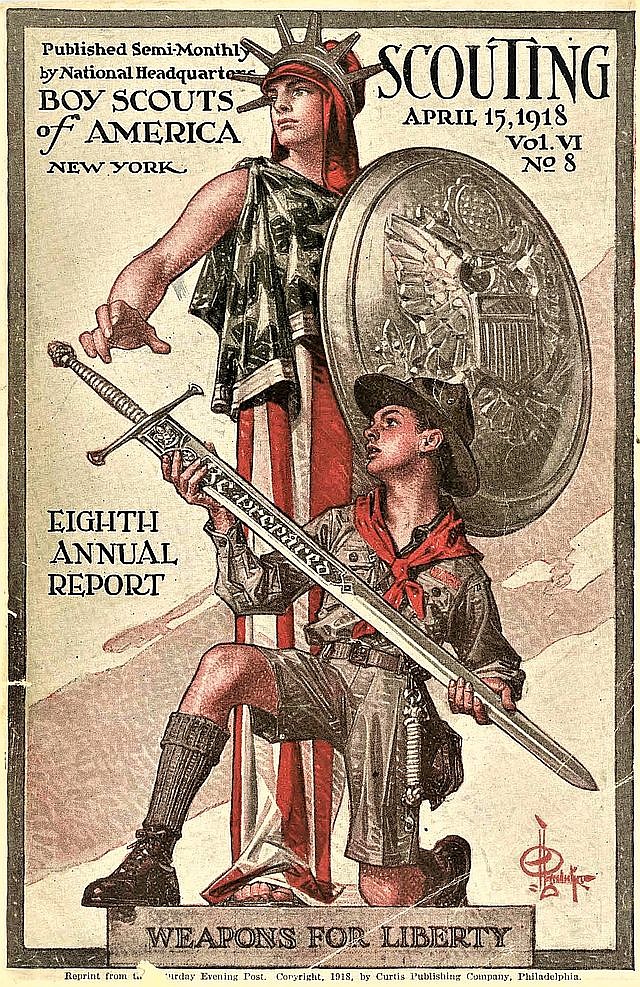Over the years, there have been many organizations that catered to the needs and interests of the boys in our community.
On Feb. 8, 1910, The Boy Scouts of America became one of those organizations and still exists today. Its appearance may be a little different and its name may have changed, but it can still be credited with making an impact on the youth of our community.
The first meeting held in Jefferson City, Dec. 11, 1910, was at the Presbyterian Church, with Scout Master Major Paul Hunt, commanding officer of Company "L" of the Missouri National Guard. By February 1911, there were 60 boys enrolled in the program. In June 1911, the Scouts had their first opportunity to parade through town as they joined the annual Decoration Day Parade, a parade they joined for many years.
In 1917, Gov. R. D. Gardner praised Mrs. Frank W. Church for her work in helping to reorganize the program in the city. She had secured the interest of more than 300 boys. That same year, the Jefferson City Boy Scout Council was formed with Hugh Stephens as president and Father Selinger as vice president.
During 1917-18, there were six troops in the city with around 30 boys each. By 1922, there were 11 troops with 91 boys.
World War I brought its toll to the program as many of the program leaders went off to war, leaving the boys with little supervision. Because they represented the largest uniformed body in the nation, President Woodrow Wilson enlisted the Boy Scouts' help in the four Liberty Bonds campaigns. Locally, they helped gain pledges for 100 bonds, a total commitment of $16,350.
Scout headquarters in 1917 was in the Merchants Bank Building, located at 101 W. High St., where they also had a gymnasium. Before that, the headquarters was in the City Hall building. In 1923, the headquarters was in the county courthouse, on the second floor in the office of the county superintendent of schools.
The biggest boost to the program came in 1923, when the Jefferson City Council hired their first Scout executive, Clyde Hesse. During his three years in office, the numbers grew from 163 to 261. At the same time, the first Negro Troop was organized at Washington School, with Principal Victor H. Collins as the first scoutmaster. By 1934, Jefferson City had three Black troops.
Camping was a regular part of the program. The Scouts camped along the Gasconade River near Rich Fountain, at the Charles R. Heinrichs property. Locally, they would camp at "Rackers Ford" along the Moreau River on land owned by Henry Rackers. Later, they camped at Camp Rota-Kiwa on Bald Hill Road. Its name came from the support of both the Rotary and the Kiwanis Clubs. From 1925-44, Camp Maries, south of Westphallia, was the council's long-term camping location. Black troops camped at Lamkin's Spring, possibly off Tanner Bridge Road just north of the Moreau River.
Annually, they held a field day of activities at Lincoln University. They also looked forward to a yearly football game at the University of Missouri in Columbia. This was started in 1924. The 1927 game attracted 1,500 Scouts from throughout Missouri.
Performing service was and is today an important part of scouting. Some of the service opportunities included participating in Flag Day programs, ushers at church services, convention messengers, helping with Fire Prevention Week, distributing Thanksgiving baskets to the poor, acting as messengers and guides for the local trachoma clinic, and helping with various cleanup projects. In 1926 and 1927, they operated a "Boy Scout Christmas Toy Shop" where, in 1926, they rebuilt more than 1,000 discarded toys for the local needy children. Scruggs-Guhleman Lumber donated most of the materials.
Awards and advancement were an integral part of the program. Ralph C. Graham, a member of Troop 1 of the Methodist Church, received the first Eagle Scout award in 1925. A 1927 graduate of Jefferson City High School, he went on to graduate from the Missouri School of Mines, later becoming a district engineer for the Security Engineering Company Inc. in Houston, Texas.
From this humble beginning, one can only ask, "Does Scouting pay?" Governor Caulfied in 1938 put it best when he said "possibly the Scouts are rendering one of the greatest services of any organization because you are making men."
Gary Elliott is the author of three books, including "The History of the Jefferson City and the Cole County Missouri Council of the Boy Scouts of America 1910-1929." Elliott is a former Boy Scout and Silver Beaver recipient. He has a music background and works as a professional land surveyor.

